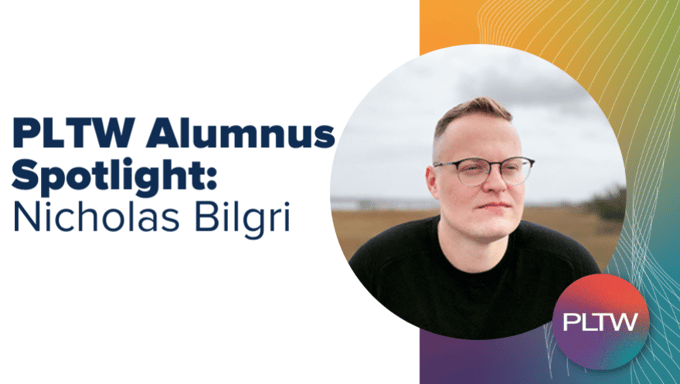For nearly 25 years, PLTW has offered transformative classroom and learning experiences for PreK-12 students. Now, many of those students are professionals in STEM fields. We recently reached out to several PLTW alumni to learn more about their educational and career journeys and find out what advice they have for current PLTW students. If you are a PLTW alumnus interested in sharing your story, we’d love to hear from you here.
Nicholas Bilgri lives in Pittsburgh, Pennsylvania and is a Designer at LS3P, as well as a graduate student at Carnegie Mellon University. In high school, Nicholas completed Introduction to Engineering Design and Civil Engineering and Architecture in the PLTW Engineering program.
In what grades did you participate in PLTW? What were some of your most memorable experiences from PLTW?
I was part of the inaugural cohort of PLTW at Neuqua Valley in 2011. I was able to take the courses my junior and senior years, which were very informative for me when I began to research and apply to colleges. Those classes were my first experience with design, and I was immediately sure it was what I wanted to pursue as a career. One of my favorite memories was a field trip we took to Chicago to tour the city via the Chicago River. I still recommend to friends visiting that they do exactly what we did as high school students.
What did your journey look like to get to where you are today?
I initially intended to pursue engineering but felt that architecture would provide me with more opportunities to be creative at various scales. I attended Clemson University and graduated with a Bachelor of Arts in Architecture in 2018. I immediately began my graduate studies and graduated in 2019 with a Master of Resilient Urban Design from Clemson University. Now, to obtain my license to practice architecture, I am pursuing my Master of Architecture from Carnegie Mellon University. My father is an engineer, so I had the chance to intern for his office while still in high school. Learning AutoCAD and other computational design tools PLTW allowed me to get an internship at a young age.
What is your current role within your company? What are your responsibilities in this position?
I have worked for an engineering office, a landscape architecture office, and an architecture design firm. I am currently working at LS3P in Charleston, South Carolina. I have the opportunity to design and assist on a wide variety of project types. I am part of their research and development team, Ignite, researching ways we can advance our practice. I recently published a thought-piece on resiliency and sea level rise in the southeast, and I am currently working on an initiative to improve the design of schools.
What did you learn in PLTW that still helps you today?
One of the things I learned in PLTW that I still use today is the iterative process and taking feedback from teachers. Also, the computer and drafting skills necessary to communicate ideas in the CEA industry. I learned Revit in my Career Advancement Activities (CAA) class, which is not usually taught in collegiate design schools, so I feel like it really gave me a leg up when applying for jobs.
Do you have any advice for current PLTW students?
Keep an open mind and do not be intimidated by the things you do not know. The classes are meant to be instructive, but playful. Have fun creating and learning!
Anything else you’d like to add?
In 2018, I had the chance to design a Career Technology wing at Baptist Hill High School in Hollywood, South Carolina. It was the first project I got to work on from conceptual design to construction. Part of the building is home to the PLTW classrooms for the school, so it really felt like my journey had come full circle.
Bonus!
We had the opportunity to also connect with one of Nicholas’ former teachers, Corey Duzan, who was part of the team that brought PLTW to Neuqua Valley and is a current Master Teacher, a role where Corey facilitates training for educators to earn PLTW teaching credentials.
Corey, do you have any advice for PLTW teachers?
We were always out to have as much fun as we possibly could in class. We would take any sort of standard or objective and try to spin it to make it as much fun for the students and teachers. It comes down to building those student-teacher relationships and creating a bond. I’ve been teaching for 17 or 18 years and this is a great example, Nick and I have been able to stay in contact and we’re friend’s on social media. We are still able to communicate eight or nine years later. So, yes, the content is great and those skills, the collaboration and design processes, are going to prepare kids for the future, but having the most fun you possibly can in class, getting those kids interested, and staying connected with them is so important. Then, they will be really prepared for college and they’ll do great things just like Nick is doing right now.
__
PLTW provides PreK-12 schools, teachers, and students with hands-on, interdisciplinary STEM-based curriculum that uniquely prepares students for life and their future careers.
PLTW rejuvenates teachers, providing world-class experiences that keep them on the forefront of how to prepare students for the demands of tomorrow. PLTW:
- Has provided professional development opportunities to more than 80,000 teachers giving them the support and resources needed to inspire students
- Offers best-in-class teacher training: PLTW Core Training with Master Teachers
- Continuously updates teacher resources that are available on demand
- Facilitates teacher networking opportunities
- Develops curriculum by a team of writers, many of whom are former teachers
Learn more about PLTW on pltw.org


